Manjunath U. S., Sandhya P., K. V. Devadas
Department of Electrical and Electronics, KVGCE, Sullia, India
Correspondence to: Manjunath U. S., Department of Electrical and Electronics, KVGCE, Sullia, India.
| Email: |  |
Copyright © 2017 Scientific & Academic Publishing. All Rights Reserved.
This work is licensed under the Creative Commons Attribution International License (CC BY).
http://creativecommons.org/licenses/by/4.0/

Abstract
This project proposes an efficient drive system for solar power fed irrigation pumps. An interleaved zeta converter is employed for regulating the voltage from solar panels. The proposed system eliminates the phase current sensor and thus is cost effective BLDC motor is fed from VSI. The proposed system is simulated on MATLAB platform with closed loop control obtaining satisfactory results. The hardware implementation is done for open loop control using FPGA controller of Xilinx Spartan 3AN and the results are demonstrated.
Keywords:
ILZ converter, SPV array, BLDC motor, Water pump, INC-MPPT, VSI
Cite this paper: Manjunath U. S., Sandhya P., K. V. Devadas, FPGA Control of SPV Array Fed BLDC Motor Driven Water Pumping System Employing ILZ Converter, Electrical and Electronic Engineering, Vol. 7 No. 2, 2017, pp. 11-17. doi: 10.5923/j.eee.20170702.01.
1. Introduction
Non-conventional source of energy are clean and ecofriendly and available in abundance. One of the promising non-conventional sources of energy is solar energy. This solar energy can be used in many applications like irrigation, water pumping, and solar water heater and so on. India is an agricultural country, 70% of Indians are farmers they are back bones of the nation. These farmers are still following old method of water pumping like use of diesel pumping system, use of fossil fuels etc. this leads to energy crises. In this context, SPV array generated electricity gains wide attention and appears as future prospective in agricultural fields. The MPPT technique is used to combine with ILZ converter in association with the BLDC motor. The advantages of BLDC Motor and ILZ Converter can used to develop an S-PV array fed water pumping systems. The merits of BLDC motor as follows:-• High reliability• High efficiency• High torque / inertia ratio • Improved cooling • Low radio frequency interference and noise and • Requires practically no maintenance.The ILZ converter has following merits verses conventional buck, buck – boost, and Cuk converter when used in spv based applications• ILZ converter may be operated either to higher or lower the output voltage. This gives a boundless region for maximum power point tracking (MPPT) of S-PV array.• Boost converters which highness the voltage level at its output, not ensures smooth operation, while in ILZ converter, it has facility for soft starting of BLDC motor.• ILZ converter not having discontinuous output current. An output of inductor makes the current continuous and ripples free.These advantages of the ILZ converter are good for suggested S-PV array- water pumping system. An INC-MPPT technique is makes to operate the ILZ converters and these leads to obtain MPP from SPV array. The VSI reduces the switching loss by adopting fundamental switching frequency these leads to power saving and increase efficiency. In this project the gate pulses for VSI are given by use of FPGA (Field programing gate array).
2. Block Diagram of the Simulated System in MATLAB
The general diagram of the suggested system is shown in fig 1. Solar panels are connected to the interleaved zeta converter to step-up the voltage, also used to extract more power. By this BLDC motor has smooth operation and controlling of speed on the joined water pump. Due to a controllable switches converter has very good efficiency and reduces pressure of the power devices and components because of continuous conduction mode (CCM) operation. The MPPT is used to track the high power drawn from the pv array. The controlled step up output is given to the three phase voltage source inverter is deduct the switching loss by adopting fundamental switching frequency hence increased efficiency and power saving. Then VSI connected to the BLDC motor, it achieves smooth operation by valid initialization of MPPT algorithm of PV array. FPGA controller produces a pulses and driver circuit used to enhance the pulses and isolate the from the MOSFET switches.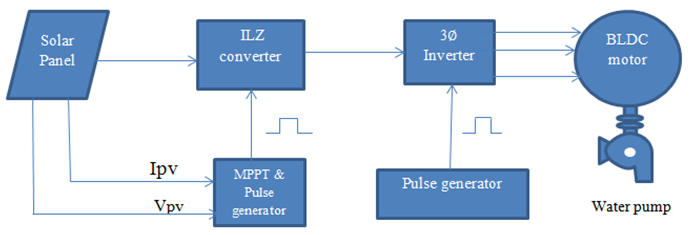 | Figure 1. General Diagram of SPV arrangement for water pumping application |
2.1. Design of Proposed System
Fig.2 shows a various operating stages are properly designed in order to get an effective water pumping system, the detailed design are described as follows.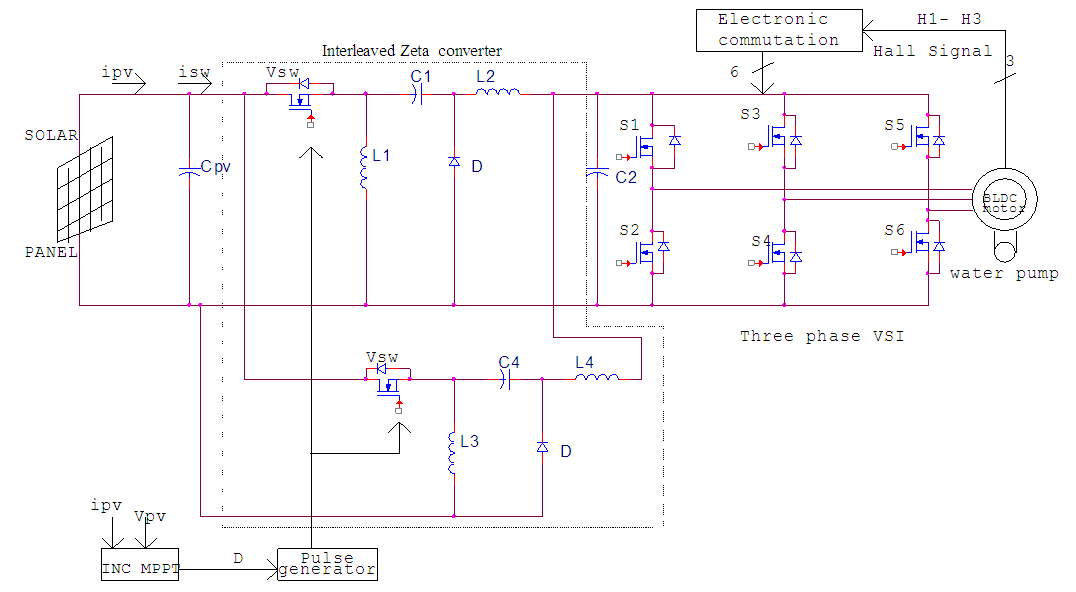 | Figure 2. Proposed SPV –ILZ converter fed BLDC motor drive for water pump |
2.1.1. Design of SPV Array
The size of the SPV array is selected slightly more than demanded peak power capacity of motor-pump.Electrical specification, parameter and formulae of SPV array are shown in table 1.Table 1. Specifications of Sanyo HIP-225HDE1 spvmodule
 |
| |
|
The current of SPV array at MPP, Impp is estimated as, | (1) |
The numbers of module required to connect in series are as, | (2) |
The number of modules required to connect in parallel are as, | (3) |
2.1.2. Design of ILZ Converter
The next stage is interleaved zeta converter in this to design various components like inductor and capacitor are in CCM resulting in reduced stress on its components and devices.An estimation of duty cycle D, | (4) |
An average current flowing through the DC link of VSI, Idc is estimated as, | (5) |
Then L1, L2 and C1 are estimated as, | (6) |
 | (7) |
 | (8) |
2.1.3. Estimation of DC Link Capacitor of VSI
The value of DC link capacitor of VSI are calculated by two frequencies rated speed and minimum speed, | (9) |
 | (10) |
Where ωrated and ωmin are  | (11) |
 | (12) |
3. Control of Proposed System
In three various stages the proposed system are controlled. The two control techniques are MPPT and electronic commutation are discussed as follows.
3.1. INC-MPPT Algorithm
For solar PV applications INC-MMPT technique are commonly used in order to obtain high power from PV array and to help smooth operation of BLDC motor. Fig 3 shows the slope of Ppv-vpv curve of INC-MPPT i.e.  | (13) |
 | Figure 3. INC-MPPT with SPV array Ppv-Vpv characteristic |
Since  | (14) |
Therefore eqn (13) is rewritten as  | (15) |
By this equations increases /decreases the duty cycle.
3.1.1. Electronic Commutation of BLDC Motor
The BLDC motor is driven by  inverter through an electronic commutation of motor. The motor is operated at
inverter through an electronic commutation of motor. The motor is operated at  conduction mode. 6 switching pulses are generated as per various possible combinations of three hall signals. These hall signals are produced by inbuilt encoder according to the rotor position.
conduction mode. 6 switching pulses are generated as per various possible combinations of three hall signals. These hall signals are produced by inbuilt encoder according to the rotor position.
3.1.2. FPGA Controller
For the generation of PWM signal microcontroller can also be used but it has lots of hierarchical rules and commands over its input and output. Microprocessor can perform loops, timings, conditioned branching, and calculations like a small PC under program control they are used where the operation is relatively complex but processing speed relatively less than FPGA. FPGA is only an array of gate that can be connected as the user wishes. FPGA are used for relatively simpler operations but higher processing speed in comparison to microcontrollers.
4. Simulated Performance of Proposed System
The proposed Solar PV array fed BLDC motor driven water pumping system employing ILZ converter is modeled using MATLAB/SIMULINK.The closed loop model is simulated with the following parameter values.Input voltage (Vin) = 20.3 VInductor (L1, L2, L3 & L4) = 5×10-3HCapacitor C1=C4=2.2×10-6F C2=1500×10-6FTable 2. Simulation results
 |
| |
|
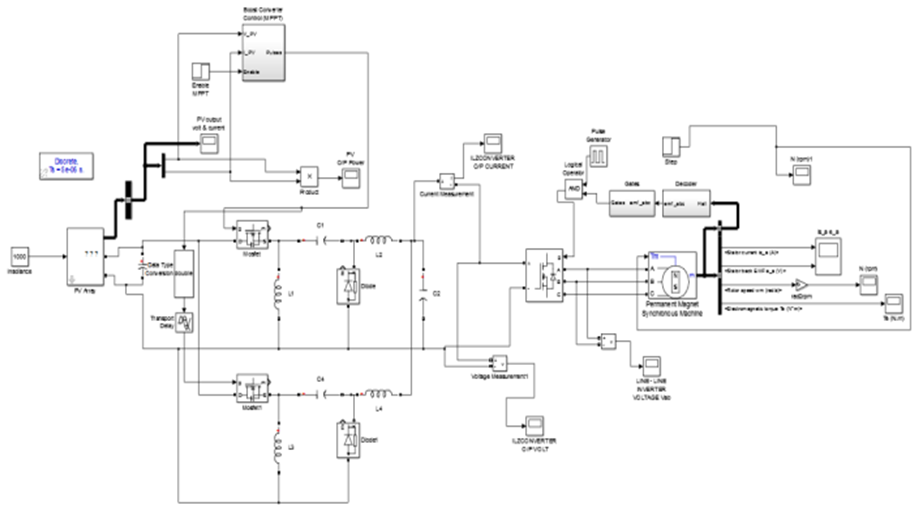 | Figure 4. SIMUlation model of SPV array fed BLDC motor driven water pumping employing ILZ converter |
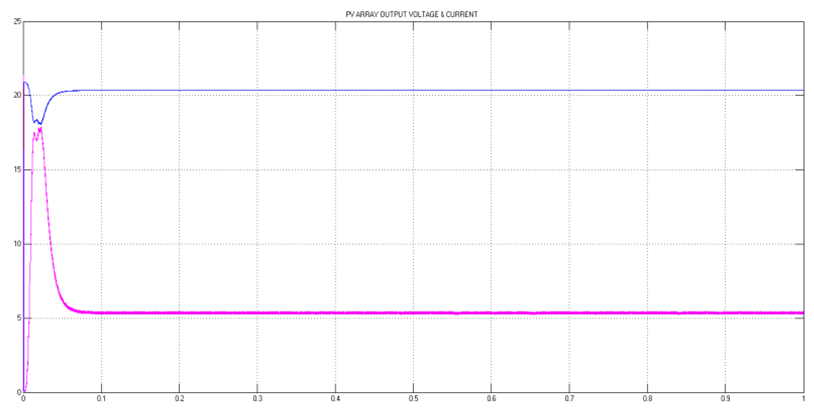 | Figure 5. Solar – PV output voltage and current |
 | Figure 6. PWM output |
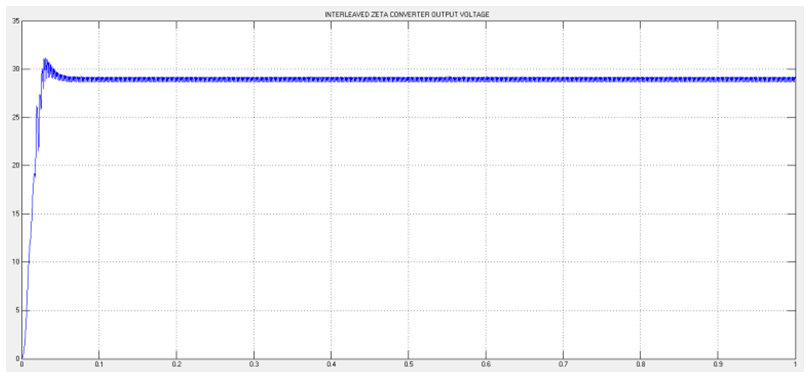 | Figure 7. ILZ converter output voltage |
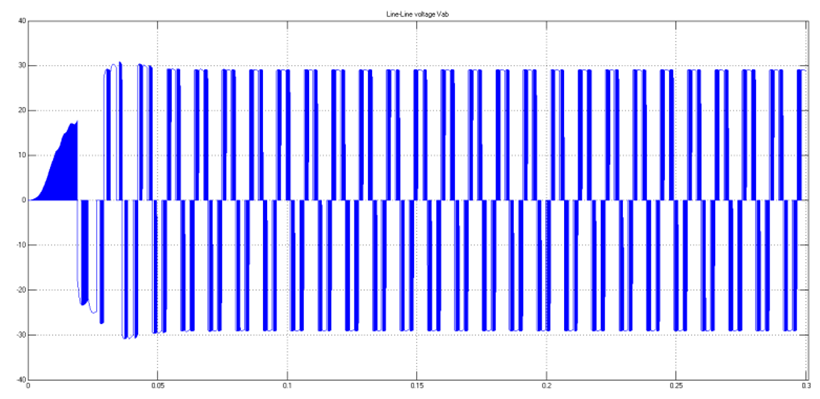 | Figure 8. Line-line voltage of 3- inverter |
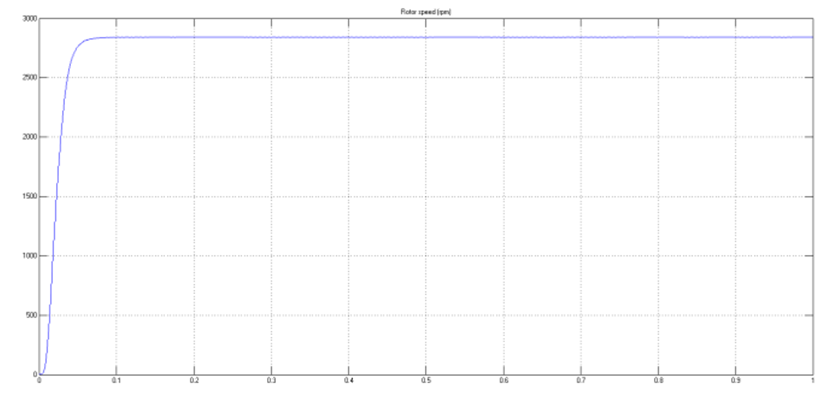 | Figure 9. Rotor speed of BLDC motor |
5. Hardware Implementation of the Proposed System
Fig 10 shows the hardware implementation of proposed FPGA control of Solar-Photovoltaic array fed BLDC motor drive water pumping system employing ILZ converter. In this hardware circuit the electrical supply is taking from solar panel and is connected to battery for charging, output of the battery is connected to diode full bridge rectifier with filter capacitor in order to produce dc voltage. This dc voltage having ripple in the signal to overcome ripple voltage regulator is used than constant dc voltage is attained. For indication purpose LED is used with current limiting resistor is protect the LED. In this hardware we used W01G diode full bridge rectifier and 7805 voltage rectifier, where 78 means positive, 05 means 5V. Next these signals move on the gate driver circuit to increase the switching voltages of MOSFET. Driver circuit has optocoupler and buffer circuit from this stable dc output get. This DC voltage is given to ILZ converter circuit which act as step-up converter. Here N- channel MOSFET is used. The boost voltage of 24volt is then given the  voltage source inverter circuit kit, in this kit also having power circuit and driver circuit section is used. For 6 MOSFET switches of inverter circuit the switching gate pulse are given through the FPGA controller. Xilinx Spartan 3AN FPGA family kit is used to generate PWM signal this signal applied to the S1 to S6 switches. Voltage source inverter it converts the DC voltage signal to three phase AC signal. This ac signal given to the BLDC motor, then its starts rotating at rated speed.
voltage source inverter circuit kit, in this kit also having power circuit and driver circuit section is used. For 6 MOSFET switches of inverter circuit the switching gate pulse are given through the FPGA controller. Xilinx Spartan 3AN FPGA family kit is used to generate PWM signal this signal applied to the S1 to S6 switches. Voltage source inverter it converts the DC voltage signal to three phase AC signal. This ac signal given to the BLDC motor, then its starts rotating at rated speed.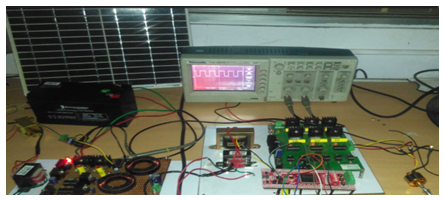 | Figure 10. Hardware implementation of proposed FPGA control of S-PV array through ILZ converter via BLDC motor water pumping system |
 | Figure 11. PWM output |
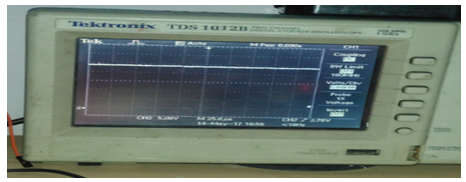 | Figure 12. ILZ output voltage |
 | Figure 13. Three phase line-line inverter voltage |
Table 3. Hardware result
 |
| |
|
6. Conclusions
For domestic and irrigational applications solar water pumping system has been proposed and demonstrated. Simulated result of the proposed model in MATLAB/SIMULINK is giving satisfactory results for closed loop control. The same is implemented in hardware using FPGA Xilinx Spartan 3AN controller for open loop control and satisfactory results were obtained.FPGA is a very flexible controller, hence can be reprogrammed and reused based upon future modification and requirements.
ACKNOWLEDGEMENTS
I express my sincere gratitude to Mrs. Sandhya P, Asso. Professor, Dept of E&E, for her cooperation and guidance. I extend my sincere thanks to our esteemed institution KVGCE, & VTU Belgaum in carrying out the research work.
References
| [1] | Samresh Satapathy., K. Mahesh. Dash., and B. Chitti Babu., “Variable Step Size MPPT Algorithm For Photovoltaic Array Using Zeta Converter- A Comparative Analysis”., Student Conference on engineering and System 12-14 April 2013. |
| [2] | Zhou Xuesong., Song Daichun., Ma Youjie., and Cheng Deshu., “The simulation and design for MPPT of PV system Based on Incremental Conductance Method”. WASE international conference on information engineering., vol2 14-15 Aug 2010., pp., 314-317. |
| [3] | R.F. Coelho., W. M.dos Santos., and D.C. Martins., “Influence of power converters on PV Maximum power point tracking algorithm”. 10th IEEE/IAS international conference on industrial applications. 5-7 Nov, 2012. |
| [4] | Ke-Ming Chen., Tsorng-Juu Liang., “Design and Implementation of Interleaved Single-Phase Power Factor Correction of Zeta Converter”. |
| [5] | D.N. Sonawane., M.S. Sutone., B.N. Choudhari., and abhijeet. Badurkar., “FPGA implementation of Simplified SVPWM Algorithm for three phase voltage source inverter”, international journal of computer and electrical engineering., vol2., no 6. Dec 2010. |
| [6] | J. Padhye, V. Firoiu, D. Towsley, "A stochastic model of TCP Reno congestion avoidance and control", Univ. of Massachusetts, Tech. Rep. 99-02, 1999. |
| [7] | B. Axelrod, and Y. Berkovich “New coupled inductor SEPIC converter with very high conversion ratio and reduced voltage stress on the switches”. |





















 inverter through an electronic commutation of motor. The motor is operated at
inverter through an electronic commutation of motor. The motor is operated at  conduction mode. 6 switching pulses are generated as per various possible combinations of three hall signals. These hall signals are produced by inbuilt encoder according to the rotor position.
conduction mode. 6 switching pulses are generated as per various possible combinations of three hall signals. These hall signals are produced by inbuilt encoder according to the rotor position.





 voltage source inverter circuit kit, in this kit also having power circuit and driver circuit section is used. For 6 MOSFET switches of inverter circuit the switching gate pulse are given through the FPGA controller. Xilinx Spartan 3AN FPGA family kit is used to generate PWM signal this signal applied to the S1 to S6 switches. Voltage source inverter it converts the DC voltage signal to three phase AC signal. This ac signal given to the BLDC motor, then its starts rotating at rated speed.
voltage source inverter circuit kit, in this kit also having power circuit and driver circuit section is used. For 6 MOSFET switches of inverter circuit the switching gate pulse are given through the FPGA controller. Xilinx Spartan 3AN FPGA family kit is used to generate PWM signal this signal applied to the S1 to S6 switches. Voltage source inverter it converts the DC voltage signal to three phase AC signal. This ac signal given to the BLDC motor, then its starts rotating at rated speed.



 Abstract
Abstract Reference
Reference Full-Text PDF
Full-Text PDF Full-text HTML
Full-text HTML

